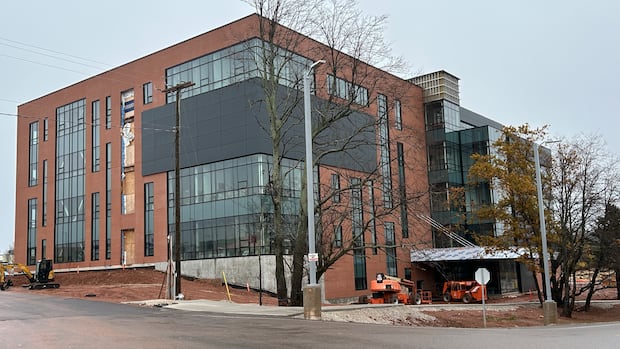Science
UPEI Launches Innovative Medical Simulation Centre for Students

The University of Prince Edward Island (UPEI) has inaugurated a new Clinical Learning and Simulation Centre (CLSC) designed to enhance the training of future healthcare professionals. This facility allows students to engage in hands-on learning through advanced simulations and standardized patient interactions, preparing them for real-world medical scenarios.
The CLSC features high-tech manikins and recreated clinical environments that mirror actual hospital settings. This approach aims to bridge the gap between theoretical knowledge and practical application, enabling students to develop essential skills before treating real patients.
Catherine O’Brien, an experienced actor and director, plays a pivotal role in this innovative training program. She began her journey in medical simulation at the University of Toronto, where she participated in similar programs. Now, she works part-time at UPEI’s CLSC as a standardized patient, portraying scripted roles to assist students in honing their interviewing and diagnostic skills. “They will learn how to interview, how to ask the right questions, how to make the patient feel comfortable using empathy,” O’Brien stated during a recent interview on CBC’s Island Morning.
Realistic Training for Future Healthcare Professionals
The CLSC aims to create a supportive and safe environment for students. O’Brien emphasizes the importance of this setting, stating that it allows students to practice in a realistic atmosphere without the pressure of working with actual patients. The standardized patients come from diverse backgrounds, not limited to actors, to reflect a wide array of real-life scenarios.
Paul Charles, the simulation program manager, detailed the extensive resources available at the CLSC. The centre includes realistic clinical hospital rooms equipped with medication carts and vital signs monitors. Students train with high-fidelity manikins capable of simulating various medical conditions, including breathing, talking, and even experiencing heart attacks or seizures. This comprehensive training approach enables students to build confidence and competence, ultimately improving patient outcomes.
Beyond student training, the CLSC also serves healthcare professionals looking to refresh their skills. Tammie Muise, the centre’s director, highlighted an exciting new addition to their resources—a mobile “simulation rig.” This trailer mimics the interior of an ambulance, allowing professionals to practice emergency responses in real-time scenarios, such as managing a stroke or heart attack. “They can really fine-tune those skills to help improve patient outcomes,” Muise explained.
Engagement with the Medical Community
The CLSC not only focuses on education but also fosters collaboration between students and healthcare professionals. O’Brien has already interacted with members of the medical school’s inaugural cohort and is eager to continue her work with them in upcoming training sessions. “I have a few coming up, which I’m excited to get going with,” she shared.
As UPEI’s medical school prepares to welcome its first students, the CLSC stands as a testament to the institution’s commitment to innovative medical education. By integrating advanced simulation technology with hands-on training, UPEI is positioning its graduates to excel in the healthcare field, ultimately benefiting the community they serve.
-

 Lifestyle2 months ago
Lifestyle2 months agoWinnipeg Celebrates Culinary Creativity During Le Burger Week 2025
-

 Health2 months ago
Health2 months agoMontreal’s Groupe Marcelle Leads Canadian Cosmetic Industry Growth
-

 Science2 months ago
Science2 months agoMicrosoft Confirms U.S. Law Overrules Canadian Data Sovereignty
-

 Education2 months ago
Education2 months agoRed River College Launches New Programs to Address Industry Needs
-

 Technology2 months ago
Technology2 months agoDragon Ball: Sparking! Zero Launching on Switch and Switch 2 This November
-

 Science2 months ago
Science2 months agoTech Innovator Amandipp Singh Transforms Hiring for Disabled
-

 Technology1 week ago
Technology1 week agoDiscord Faces Serious Security Breach Affecting Millions
-

 Technology2 months ago
Technology2 months agoGoogle Pixel 10 Pro Fold Specs Unveiled Ahead of Launch
-

 Science2 months ago
Science2 months agoChina’s Wukong Spacesuit Sets New Standard for AI in Space
-

 Technology2 months ago
Technology2 months agoWorld of Warcraft Players Buzz Over 19-Quest Bee Challenge
-

 Education2 months ago
Education2 months agoAlberta Teachers’ Strike: Potential Impacts on Students and Families
-

 Technology2 weeks ago
Technology2 weeks agoHuawei MatePad 12X Redefines Tablet Experience for Professionals
-

 Business2 months ago
Business2 months agoDawson City Residents Rally Around Buy Canadian Movement
-

 Business2 months ago
Business2 months agoNew Estimates Reveal ChatGPT-5 Energy Use Could Soar
-

 Science2 months ago
Science2 months agoXi Labs Innovates with New AI Operating System Set for 2025 Launch
-

 Technology2 months ago
Technology2 months agoInnovative 140W GaN Travel Adapter Combines Power and Convenience
-

 Technology2 months ago
Technology2 months agoFuture Entertainment Launches DDoD with Gameplay Trailer Showcase
-

 Technology2 months ago
Technology2 months agoGlobal Launch of Ragnarok M: Classic Set for September 3, 2025
-

 Technology2 months ago
Technology2 months agoNew IDR01 Smart Ring Offers Advanced Sports Tracking for $169
-

 Business2 months ago
Business2 months agoBNA Brewing to Open New Bowling Alley in Downtown Penticton
-

 Technology2 months ago
Technology2 months agoArsanesia Unveils Smith’s Chronicles with Steam Page and Trailer
-

 Science2 months ago
Science2 months agoNew Precision Approach to Treating Depression Tailors Care to Patients
-

 Technology2 months ago
Technology2 months agoHumanoid Robots Compete in Hilarious Debut Games in Beijing
-

 Health2 months ago
Health2 months agoGiant Boba and Unique Treats Take Center Stage at Ottawa’s Newest Bubble Tea Shop










